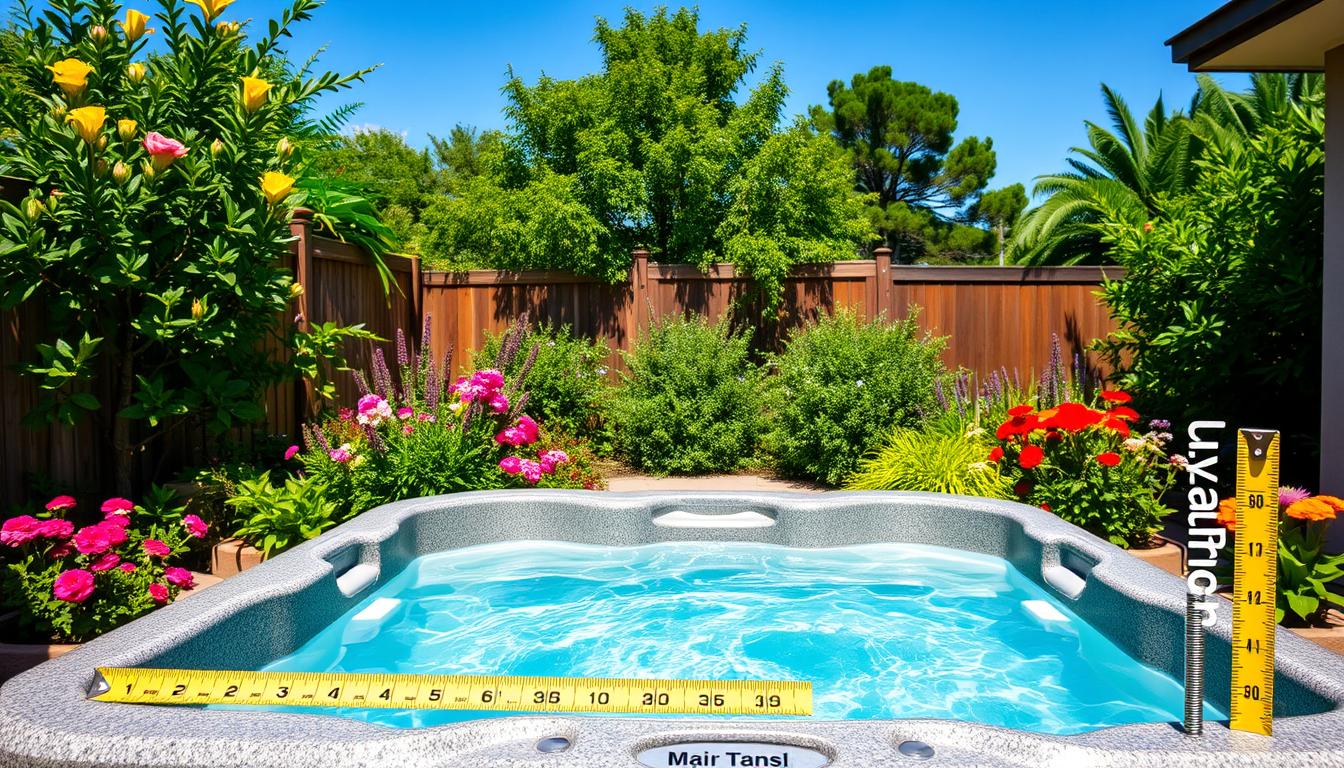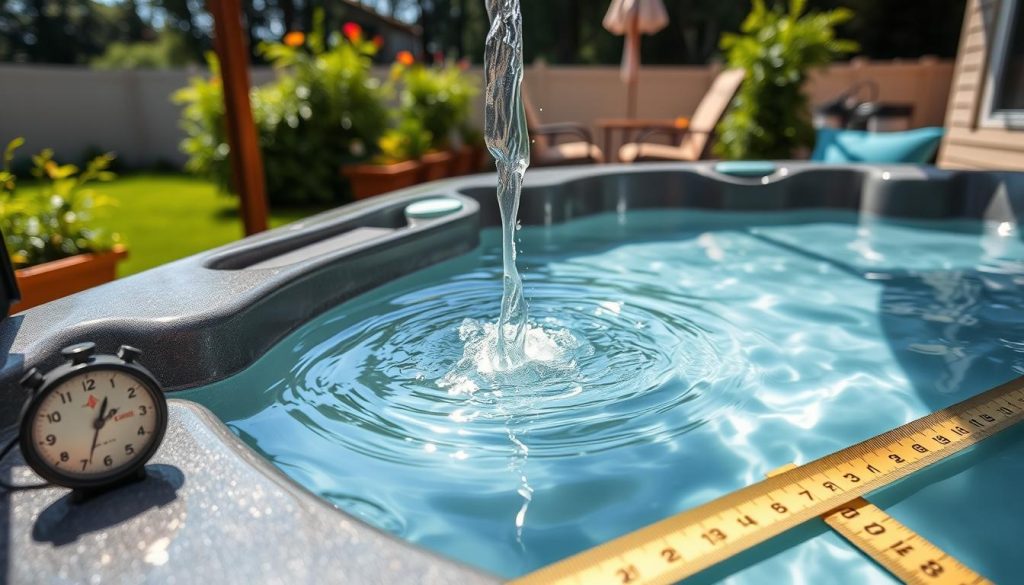
Hot tub water capacity is crucial for setup and maintenance. It determines water requirements for filling, chemical treatment, and energy efficiency. Understanding your hot tub’s volume helps create a perfect backyard oasis.
The hot tub water capacity varies by size and model. A 4-6 person hot tub typically holds 375 gallons. Larger models can hold up to 600 gallons.
Swim spas offer relaxation and exercise options. Small swim spas hold about 1450 gallons. Larger, family-sized models can contain up to 2500 gallons.
Accurate hot tub water calculations ensure proper water chemistry. Knowing your spa’s volume helps measure chemicals precisely. This maintains a balanced environment for safe, healthy soaking.
Let’s explore factors influencing hot tub water capacity. We’ll also cover methods for calculating your spa’s unique water requirements.
Factors Affecting Hot Tub Water Capacity
Several factors influence a hot tub’s water capacity. The shape, size, and interior features all play a role. These elements help determine how much water your hot tub needs.
Understanding these factors is key for proper hot tub use. It ensures you fill your tub to the right level. This knowledge also helps estimate water consumption.
Hot Tub Shape and Size
A hot tub’s shape and size are the main factors in its water capacity. Square and rectangular tubs differ in volume from round or multi-sided ones. The tub’s length, width, and water depth determine total water volume.
- A small hot tub designed for two to three people can hold between 200 to 300 gallons of water.
- Medium-sized hot tubs accommodating four to six individuals usually have a water capacity of 300 to 400 gallons.
- Large hot tubs, suitable for seven or more guests, may have a water volume of 500 gallons or more.
Interior Features and Displacement
Interior features like seats, loungers, and jets affect water capacity. They displace water, changing the total volume. Portable acrylic-fiberglass tubs often have more water-displacing features than other types.
In-ground, soft, or wooden hot tubs typically displace less water. This difference is important when calculating total water volume.
| Hot Tub Type | Typical Water Displacement |
|---|---|
| Portable Acrylic-Fiberglass | High |
| In-Ground | Low to Moderate |
| Soft | Low |
| Wooden | Low to Moderate |
Knowing your hot tub’s shape, size, and features helps estimate water capacity. This info is crucial for proper water use and maintenance. It ensures optimal performance and correct water chemistry.
Calculating Hot Tub Water Volume
Knowing your hot tub’s water volume is crucial for proper care and safety. Two main methods exist: the fill time method and the dimensional method. The fill time method is more accurate, while the dimensional method offers a quick estimate.
Fill Time Method
This method involves timing how long it takes to fill your hot tub and a bucket. Use the same hose and pressure for both. Divide the hot tub fill time by the bucket fill time.
For example, if a swim spa fills in 30 minutes and a one-gallon bucket in 6 seconds, the volume is 300 gallons. Using a five-gallon bucket can improve accuracy.

Dimensional Method for Portable Acrylic-Fiberglass Hot Tubs
This method estimates volume using the hot tub’s outside dimensions. Different formulas apply based on the tub’s shape. For square or rectangular tubs, use this formula:
Volume (in gallons) = Length (in inches) × Width (in inches) × Average Depth (in inches) × 7.5 ÷ 1728
For round or multi-sided tubs, use this formula:
Volume (in gallons) = (Radius (in inches) × Radius (in inches) × Average Depth (in inches) × 3.14) ÷ 231
Remember, these results are estimates. For accurate information, consult your swim spa manufacturer.
Dimensional Method for In-Ground, Soft, and Wooden Hot Tubs
These tubs have fewer interior water-displacing features. The formulas use inside measurements of length, width, and average water depth. They differ slightly from those for portable acrylic-fiberglass tubs.
| Hot Tub Shape | Formula |
|---|---|
| Square/Rectangular | Volume (in gallons) = Length (in inches) × Width (in inches) × Average Depth (in inches) × 7.5 ÷ 1728 |
| Round | Volume (in gallons) = (Radius (in inches) × Radius (in inches) × Average Depth (in inches) × 3.14) ÷ 231 |
| Oval | Volume (in gallons) = Length (in inches) × Width (in inches) × Average Depth (in inches) × 5.9 ÷ 1728 |
For hot tubs with sloped sides, multiply the calculated volume by 0.85. This adjustment accounts for the reduced volume.
Knowing your hot tub’s water volume offers several advantages. It helps with proper water treatment, cost estimation, and structural safety. It also improves energy efficiency by maintaining the correct water level.
- Proper water treatment: Determining the right amount of chemicals and sanitizers for maintenance
- Cost estimation: Understanding the costs of filling and treating the water
- Structural safety: Ensuring the deck or patio can support the hot tub’s weight and occupants
- Energy efficiency: Maintaining the correct water level to reduce water heating requirements
Average Water Capacity for Different Hot Tub Sizes
Hot tub size affects water capacity, which is crucial when buying one. Small hot tubs fit 2-4 people and hold 200-500 gallons. They’re perfect for intimate gatherings and personal relaxation.
Compact models use less energy and are easier to maintain. This makes them a cost-effective choice for smaller spaces.
Medium-sized hot tubs seat 4-6 people comfortably. They have a water capacity of 300-700 gallons. These tubs offer a more immersive experience with room to stretch out.
Larger families or those who entertain often will enjoy medium-sized tubs. They provide versatility for various social situations.
Large hot tubs fit seven or more people. They hold an impressive 500-1000 gallons of water. These models are great for hosting big gatherings.
Remember, larger tubs use more energy and need more maintenance. Consider these factors when choosing the right hot tub for you.







